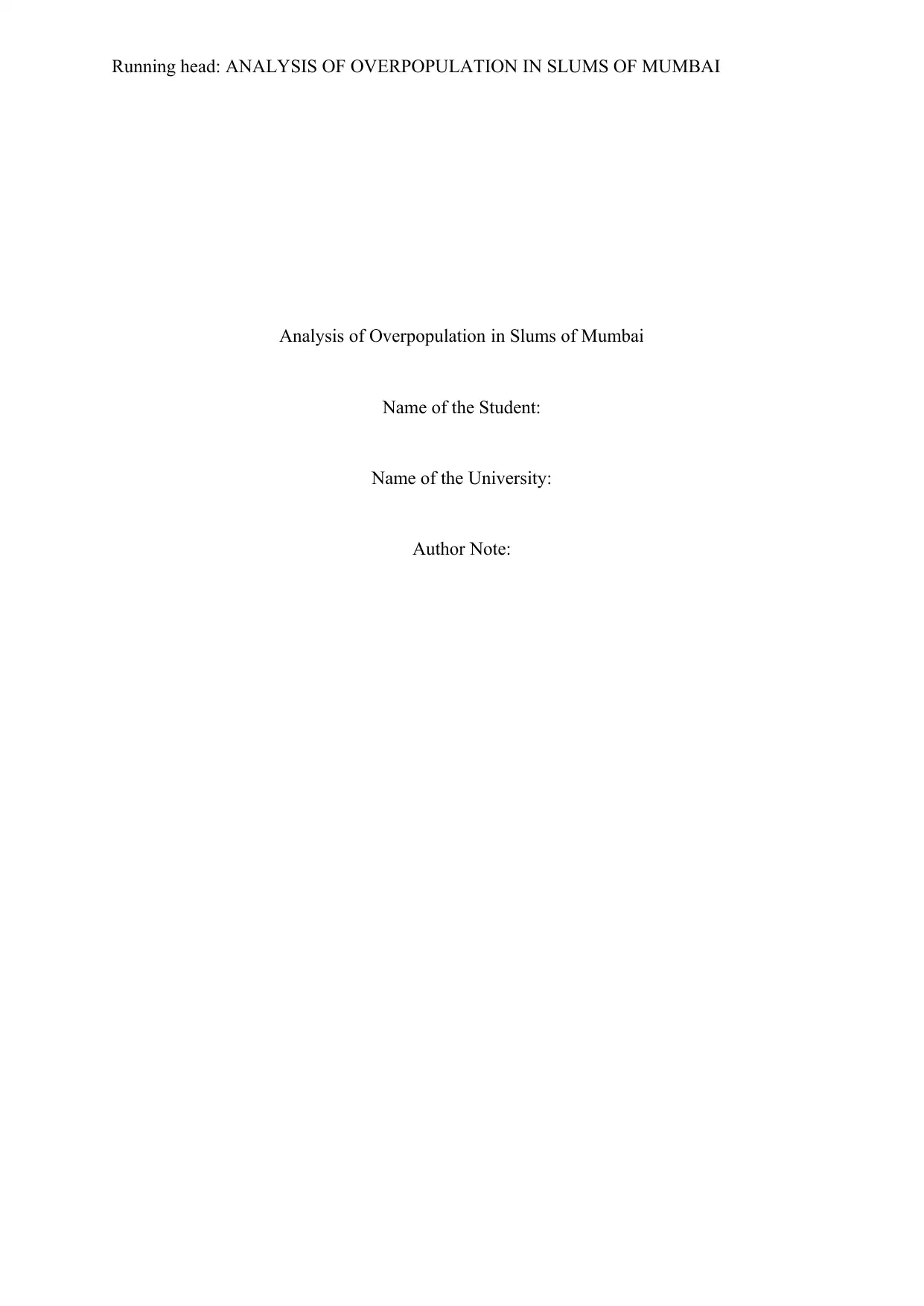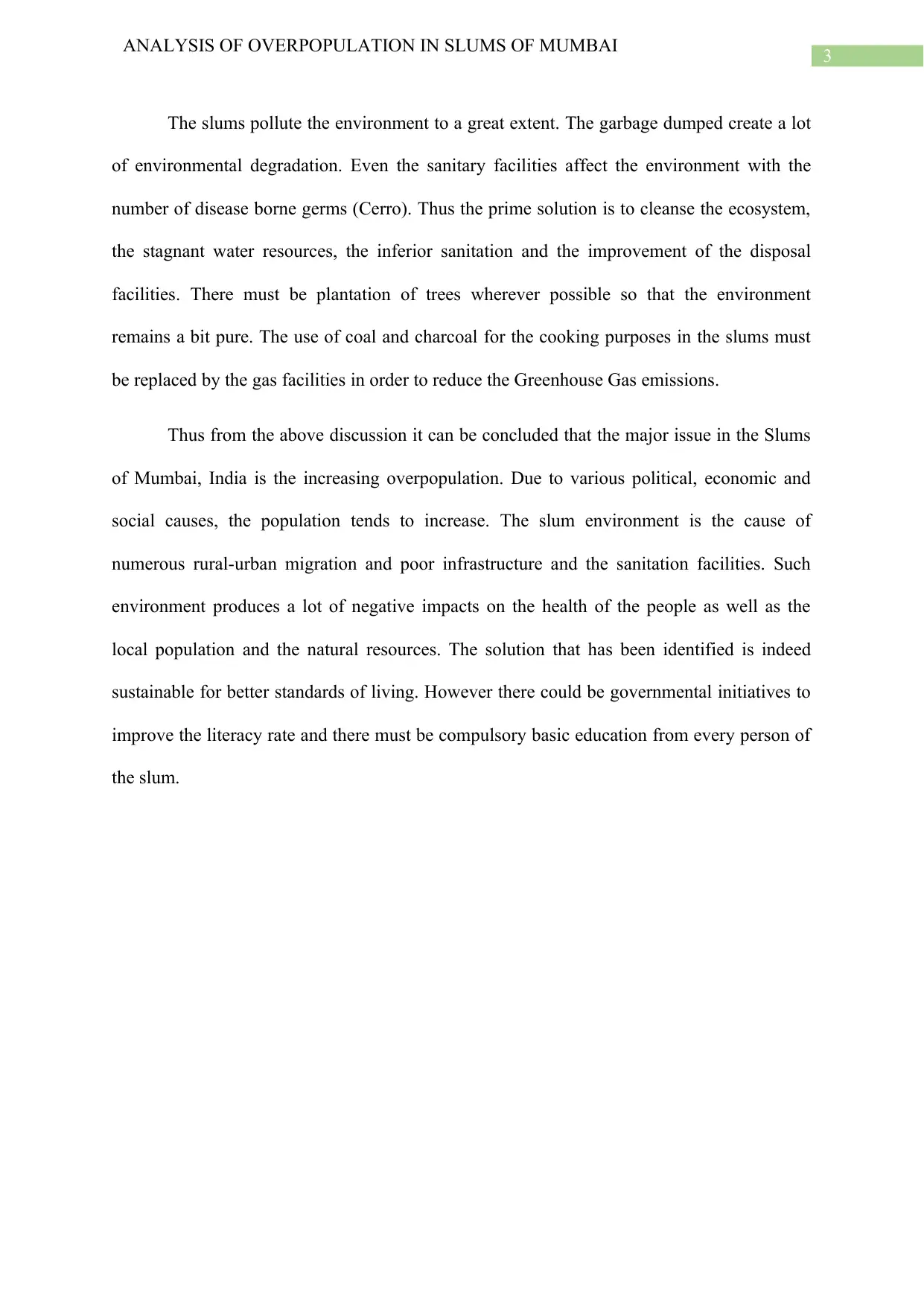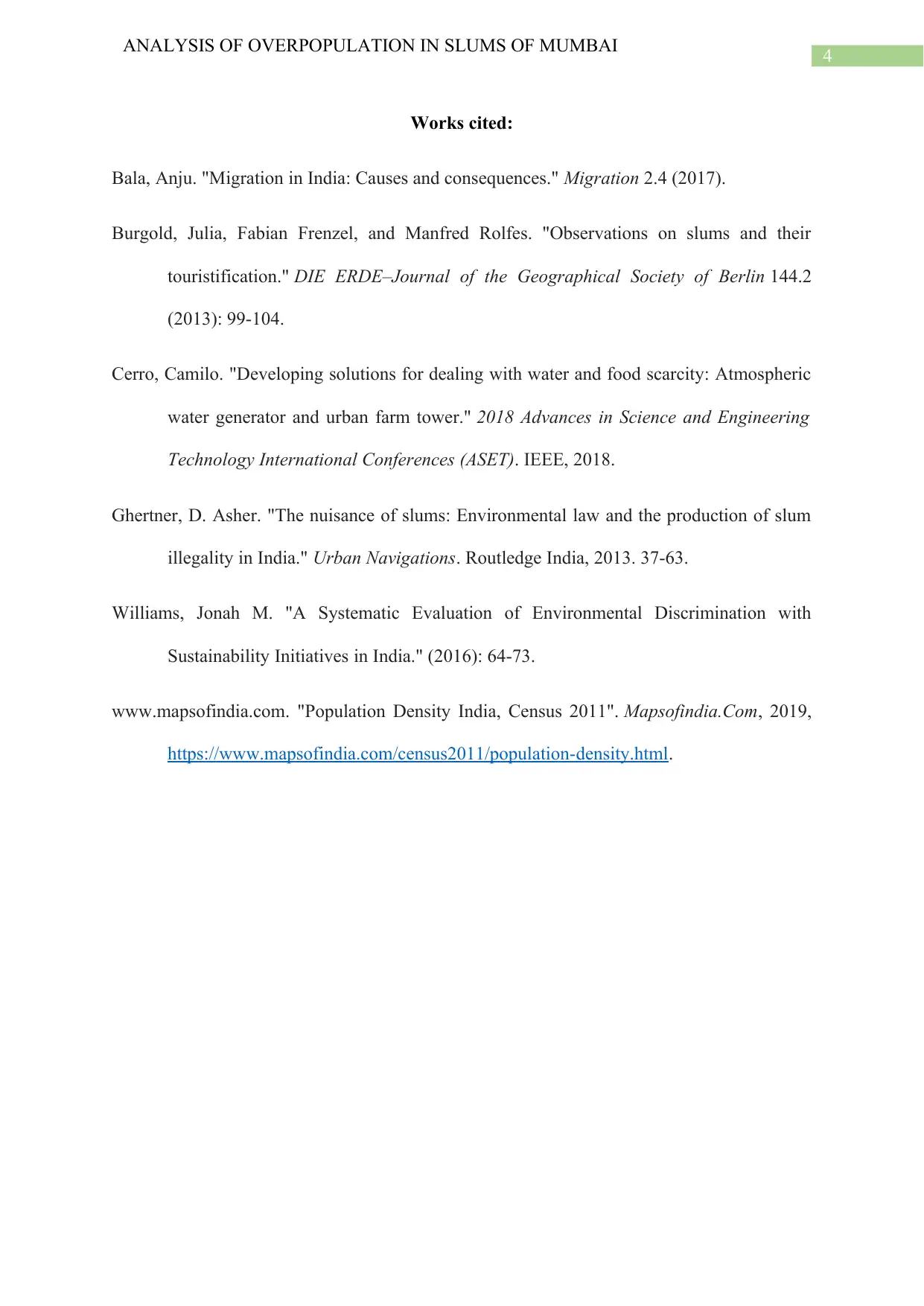Geographic Issues: Analysis of Overpopulation in Mumbai Slums
VerifiedAdded on 2022/10/12
|5
|1157
|492
Report
AI Summary
This report provides a comprehensive analysis of overpopulation in the slums of Mumbai, India. It explores the root causes, including migration from rural areas due to industrialization and unemployment, lack of proper planning, and natural disasters. The consequences discussed include poor sanitation, waterborne diseases, environmental degradation, and depletion of natural resources. The report suggests economic solutions such as increased employment and education, along with social solutions like improved literacy and family planning. Environmental solutions focus on cleansing the ecosystem, improving sanitation, and promoting green initiatives. The study highlights the need for governmental initiatives to improve living standards, infrastructure, and education to combat the challenges of overpopulation in Mumbai's slums, emphasizing the interconnectedness of social, economic, and environmental factors.

Running head: ANALYSIS OF OVERPOPULATION IN SLUMS OF MUMBAI
Analysis of Overpopulation in Slums of Mumbai
Name of the Student:
Name of the University:
Author Note:
Analysis of Overpopulation in Slums of Mumbai
Name of the Student:
Name of the University:
Author Note:
Paraphrase This Document
Need a fresh take? Get an instant paraphrase of this document with our AI Paraphraser

1
ANALYSIS OF OVERPOPULATION IN SLUMS OF MUMBAI
The major problem of overpopulation is present in the slums of Mumbai, India. The
city is the growth of unlawful settlements with the lack of planned access, lack of
unemployment and lack of proper sanitation systems. The population density of India is
approximately 364.9 per km2 and is termed as the 31st most densely populated country in the
world ( www.mapsofindia.com ). Almost 540 million people of India are living below the
international poverty line and almost one third of the poor people of the world reside in India.
The issue of overpopulation is defined as an undesirable condition where the ratio of the
existing human population to the carrying capacity of the earth increases than the desired
condition. This results in the poor living conditions causing food insecurity and food crisis.
This paper is aimed at finding the solution of overpopulation and how can it be eradicated.
The structure of the paper involves the cause of the issue, its consequences, and its economic,
social as well as environmental solution.
The sprouting and expansion of slums in the city of Mumbai in India happens due to
several demographic, political, economic and social reasons. The most common reason for
the overpopulated slums is the migration of the rural people to the urban areas due to the
advent of industrialization. According to Ghertner, urbanization is the cause of the growing
slums because there is mismanagement from the side of the government. The people tend to
migrate from the rural areas because of the presence of high level of unemployment. With the
rapid migration, the major issue of poverty migrates to urban areas. Lack of proper planning
and the lack of low cost housing also accounts for the development of more number of slums.
Out of all these factors that result in overpopulation, natural disasters are the environmental
events which cause the migration of the people from the affected areas to the unaffected ones.
The poor infrastructure, lack of affordable public transport and economic infrastructure are
the other man made reasons along with the economic stagnation of the country.
ANALYSIS OF OVERPOPULATION IN SLUMS OF MUMBAI
The major problem of overpopulation is present in the slums of Mumbai, India. The
city is the growth of unlawful settlements with the lack of planned access, lack of
unemployment and lack of proper sanitation systems. The population density of India is
approximately 364.9 per km2 and is termed as the 31st most densely populated country in the
world ( www.mapsofindia.com ). Almost 540 million people of India are living below the
international poverty line and almost one third of the poor people of the world reside in India.
The issue of overpopulation is defined as an undesirable condition where the ratio of the
existing human population to the carrying capacity of the earth increases than the desired
condition. This results in the poor living conditions causing food insecurity and food crisis.
This paper is aimed at finding the solution of overpopulation and how can it be eradicated.
The structure of the paper involves the cause of the issue, its consequences, and its economic,
social as well as environmental solution.
The sprouting and expansion of slums in the city of Mumbai in India happens due to
several demographic, political, economic and social reasons. The most common reason for
the overpopulated slums is the migration of the rural people to the urban areas due to the
advent of industrialization. According to Ghertner, urbanization is the cause of the growing
slums because there is mismanagement from the side of the government. The people tend to
migrate from the rural areas because of the presence of high level of unemployment. With the
rapid migration, the major issue of poverty migrates to urban areas. Lack of proper planning
and the lack of low cost housing also accounts for the development of more number of slums.
Out of all these factors that result in overpopulation, natural disasters are the environmental
events which cause the migration of the people from the affected areas to the unaffected ones.
The poor infrastructure, lack of affordable public transport and economic infrastructure are
the other man made reasons along with the economic stagnation of the country.

2
ANALYSIS OF OVERPOPULATION IN SLUMS OF MUMBAI
The overpopulation, population ageing, forced sterilization, food insecurity, a food
crisis of the slums in Mumbai have negative consequences which include poor sanitation
facilities causing several kinds over water borne diseases like diarrhoea (Bala). Health risks
are of a great issue in over populated slums including AIDS. The poor infrastructure affects
the water supply of the entire city since they tend to consume more water. Also the ill
drainage systems promote floods. Apart from all the overpopulation of slums cause
environmental degradation and deplete the natural resources such as water and timber.
Overcrowding of the city negatively affects the local population as the free transportation is
hampered (Burgold, Frenzel and Rolfes).
An economic solution to the major issue of overpopulation in slums include the
eradication of poverty. This can only be done with the increased rate of employment. The
men and women must have work and must be economically self-sufficient. However most
importantly to improve the job access the people should be educated with the basic education.
In order to increase the standards of livings of the slum dwellers, the dwellers’ human capital
must be increased.
The Society too plays an important role in Sustainable Development. The literacy rate
of the slums must be increased and the men and the women must be provided with the basic
education. The use of contraception and the need for family planning must be instilled among
the slum dwellers. The Government too plays an important role here. The Governmental
initiatives should promote responsible parenthood and the one-child policy must be made
compulsory(Williams). The education can only help in removing the corruption, crime and
the inequality in the society. The slum infrastructure must improve so that there is enough
access to freshwater and the sanitation facilities no longer promote illness and diseases.
ANALYSIS OF OVERPOPULATION IN SLUMS OF MUMBAI
The overpopulation, population ageing, forced sterilization, food insecurity, a food
crisis of the slums in Mumbai have negative consequences which include poor sanitation
facilities causing several kinds over water borne diseases like diarrhoea (Bala). Health risks
are of a great issue in over populated slums including AIDS. The poor infrastructure affects
the water supply of the entire city since they tend to consume more water. Also the ill
drainage systems promote floods. Apart from all the overpopulation of slums cause
environmental degradation and deplete the natural resources such as water and timber.
Overcrowding of the city negatively affects the local population as the free transportation is
hampered (Burgold, Frenzel and Rolfes).
An economic solution to the major issue of overpopulation in slums include the
eradication of poverty. This can only be done with the increased rate of employment. The
men and women must have work and must be economically self-sufficient. However most
importantly to improve the job access the people should be educated with the basic education.
In order to increase the standards of livings of the slum dwellers, the dwellers’ human capital
must be increased.
The Society too plays an important role in Sustainable Development. The literacy rate
of the slums must be increased and the men and the women must be provided with the basic
education. The use of contraception and the need for family planning must be instilled among
the slum dwellers. The Government too plays an important role here. The Governmental
initiatives should promote responsible parenthood and the one-child policy must be made
compulsory(Williams). The education can only help in removing the corruption, crime and
the inequality in the society. The slum infrastructure must improve so that there is enough
access to freshwater and the sanitation facilities no longer promote illness and diseases.
⊘ This is a preview!⊘
Do you want full access?
Subscribe today to unlock all pages.

Trusted by 1+ million students worldwide

3
ANALYSIS OF OVERPOPULATION IN SLUMS OF MUMBAI
The slums pollute the environment to a great extent. The garbage dumped create a lot
of environmental degradation. Even the sanitary facilities affect the environment with the
number of disease borne germs (Cerro). Thus the prime solution is to cleanse the ecosystem,
the stagnant water resources, the inferior sanitation and the improvement of the disposal
facilities. There must be plantation of trees wherever possible so that the environment
remains a bit pure. The use of coal and charcoal for the cooking purposes in the slums must
be replaced by the gas facilities in order to reduce the Greenhouse Gas emissions.
Thus from the above discussion it can be concluded that the major issue in the Slums
of Mumbai, India is the increasing overpopulation. Due to various political, economic and
social causes, the population tends to increase. The slum environment is the cause of
numerous rural-urban migration and poor infrastructure and the sanitation facilities. Such
environment produces a lot of negative impacts on the health of the people as well as the
local population and the natural resources. The solution that has been identified is indeed
sustainable for better standards of living. However there could be governmental initiatives to
improve the literacy rate and there must be compulsory basic education from every person of
the slum.
ANALYSIS OF OVERPOPULATION IN SLUMS OF MUMBAI
The slums pollute the environment to a great extent. The garbage dumped create a lot
of environmental degradation. Even the sanitary facilities affect the environment with the
number of disease borne germs (Cerro). Thus the prime solution is to cleanse the ecosystem,
the stagnant water resources, the inferior sanitation and the improvement of the disposal
facilities. There must be plantation of trees wherever possible so that the environment
remains a bit pure. The use of coal and charcoal for the cooking purposes in the slums must
be replaced by the gas facilities in order to reduce the Greenhouse Gas emissions.
Thus from the above discussion it can be concluded that the major issue in the Slums
of Mumbai, India is the increasing overpopulation. Due to various political, economic and
social causes, the population tends to increase. The slum environment is the cause of
numerous rural-urban migration and poor infrastructure and the sanitation facilities. Such
environment produces a lot of negative impacts on the health of the people as well as the
local population and the natural resources. The solution that has been identified is indeed
sustainable for better standards of living. However there could be governmental initiatives to
improve the literacy rate and there must be compulsory basic education from every person of
the slum.
Paraphrase This Document
Need a fresh take? Get an instant paraphrase of this document with our AI Paraphraser

4
ANALYSIS OF OVERPOPULATION IN SLUMS OF MUMBAI
Works cited:
Bala, Anju. "Migration in India: Causes and consequences." Migration 2.4 (2017).
Burgold, Julia, Fabian Frenzel, and Manfred Rolfes. "Observations on slums and their
touristification." DIE ERDE–Journal of the Geographical Society of Berlin 144.2
(2013): 99-104.
Cerro, Camilo. "Developing solutions for dealing with water and food scarcity: Atmospheric
water generator and urban farm tower." 2018 Advances in Science and Engineering
Technology International Conferences (ASET). IEEE, 2018.
Ghertner, D. Asher. "The nuisance of slums: Environmental law and the production of slum
illegality in India." Urban Navigations. Routledge India, 2013. 37-63.
Williams, Jonah M. "A Systematic Evaluation of Environmental Discrimination with
Sustainability Initiatives in India." (2016): 64-73.
www.mapsofindia.com. "Population Density India, Census 2011". Mapsofindia.Com, 2019,
https://www.mapsofindia.com/census2011/population-density.html.
ANALYSIS OF OVERPOPULATION IN SLUMS OF MUMBAI
Works cited:
Bala, Anju. "Migration in India: Causes and consequences." Migration 2.4 (2017).
Burgold, Julia, Fabian Frenzel, and Manfred Rolfes. "Observations on slums and their
touristification." DIE ERDE–Journal of the Geographical Society of Berlin 144.2
(2013): 99-104.
Cerro, Camilo. "Developing solutions for dealing with water and food scarcity: Atmospheric
water generator and urban farm tower." 2018 Advances in Science and Engineering
Technology International Conferences (ASET). IEEE, 2018.
Ghertner, D. Asher. "The nuisance of slums: Environmental law and the production of slum
illegality in India." Urban Navigations. Routledge India, 2013. 37-63.
Williams, Jonah M. "A Systematic Evaluation of Environmental Discrimination with
Sustainability Initiatives in India." (2016): 64-73.
www.mapsofindia.com. "Population Density India, Census 2011". Mapsofindia.Com, 2019,
https://www.mapsofindia.com/census2011/population-density.html.
1 out of 5
Related Documents
Your All-in-One AI-Powered Toolkit for Academic Success.
+13062052269
info@desklib.com
Available 24*7 on WhatsApp / Email
![[object Object]](/_next/static/media/star-bottom.7253800d.svg)
Unlock your academic potential
Copyright © 2020–2025 A2Z Services. All Rights Reserved. Developed and managed by ZUCOL.





